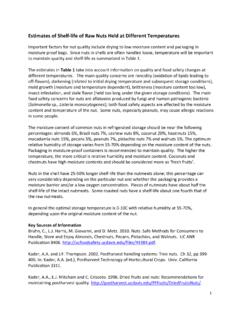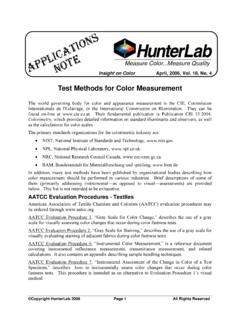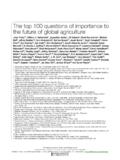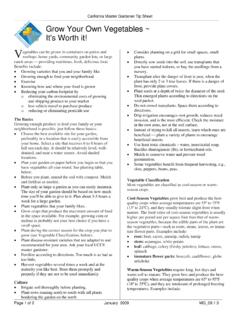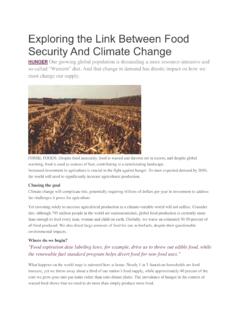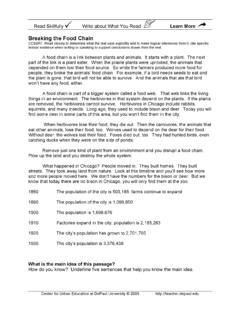Transcription of Food Insecurity and Violent Conflict: Causes, Consequences ...
1 Occasional Paper n 24 Henk-Jan Brinkman and Cullen S. HendrixJuly 2011 food Insecurity and Violent Conflict: causes , Consequences , and Addressing the ChallengesCopyright WFP 2011 All Rights Reserved. No part of this publication may be reproduced, stored in a retrieval system or transmitted, in any form by any means, electronic, mechanical, photocopying or otherwise, without priorpermission of document is available online at authors are responsible for the choice and the presentation of the facts contained in this publicationand for the opinions expressed herein, which are not necessarily of, and do not commit, WFP. Occasional Paper n 24 food Insecurity and Violent Conflict: causes , Consequences , and Addressing the ChallengesHenk-Jan Brinkman and Cullen S. HendrixJuly 20112 This paper provides an overview of the link betweenfood Insecurity and Violent conflict, addressing bothtraditional and emerging threats to security andpolitical stability.
2 It discusses the effects of foodinsecurity on several types of conflict, and thepolitical, social, and demographic factors that mayexacerbate these effects. It then discusses theinterventions that can break the link between foodsecurity and conflict, focusing on mechanisms thatcan shield consumers and producers from food priceshocks. Finally, it discusses ways in which theinternational community can assist in breaking thislink and build peace. food Insecurity especially when caused by a rise infood prices is a threat and impact multiplier forviolent conflict. It might not be a direct cause andrarely the only cause, but combined with otherfactors, for example in the political or economicspheres, it could be the factor that determineswhether and when Violent conflicts will in food security, rather than levels of foodinsecurity, are probably most influential. Foodinsecurity is neither a necessary nor a sufficientcondition for Violent conflict.
3 food price stabilizationmeasures and safety nets are critical instruments toprevent Violent conflict. food assistance cancontribute to peacebuilding, restore trust ingovernments and rebuild social Brinkman is Chief, Policy, Planning and Application in the Peacebuilding Support Office of theUnited Nations. Cullen S. Hendrix is Assistant Professor, The College of William & Mary, and Fellow, RobertS. Strauss Center for International Security and Law, University of Texas at Austin. An earlier version of thispaper was prepared as a background paper for the World Bank s World Development Report 2011: Conflict,Security and Development. At that time, Henk-Jan was Senior Adviser for Economic Policy at the World FoodProgramme (WFP). The authors wish to thank Jorge Fanlo, Alice Green, Luca Molinas, Joanna Syroka andMiyuki Yamashita for inputs, Farzad Kapadia for excellent research assistance, Vanessa Howe-Jones forediting suggestions and Steven Were Omamo and Lynn Brown and the World Development Report team forconstructive comments.
4 The views expressed in this article do not necessarily represent the official position ofWFP or the United Introduction ..42. food Insecurity as a Cause of Violence ..5 Civil Conflict ..5 Interstate War ..6 Democratic and Authoritarian Breakdowns ..6 Protest and Rioting ..7 Communal Violence ..8 Context Matters: Demographic, Social, Political, and Economic Mediators ..83. food Prices and Fragile States ..11 Focus on Fragile States ..11 Violent Conflict as a Source of Higher Prices ..124. Breaking the food Insecurity Conflict link ..13 Fragile States and Political Capacity ..13 Policy Interventions in Times of High Prices ..13 Social Protection and Safety Nets: Taking the Longer View ..145. The International Community: Answering the Call, Promoting Peace ..15 food Assistance and Peacebuilding ..15 food Assistance and Social Capital ..17 Transitions from Relief to Recovery.
5 18 Getting Aid Sequencing Right ..186. Conclusions ..20 Figure 1. food Prices and Rioting, 2007-2008 ..7 Table 1. Global factors causing high food prices ..11 Table 2. Shares of food imports in food consumption and of food in total household consumption expenditures ..12 Box: A comparison of Kenya and the United Republic of Tanzania ..9 Box: Transitioning school feeding in El Salvador ..15 Box: School meals as a safety net that contributes to peacebuilding ..16 Box: food assistance for conflict-affected populations in Mindanao, the Philippines: Peacebuilding before peace ..17 Box: WFP and IDPs in C te d Ivoire: Rebuilding social cohesion ..18 References ..21 Annex: Responses of Fragile States to High food Prices in 2007-08 ..26 Table of ContentsRising food prices contribute to food Insecurity ,which is a clear and serious threat to human in food security as a catalyst for politicalinstability and conflict has grown rapidly since2007 2008, when food protests and riots broke outin 48 countries as a result of record world prices.
6 InFebruary 2011, the food price index of the food andAgriculture Organization of the United Nations(FAO) reached a new historic peak, and the rise infood prices contributed to the wave of protests acrossNorth Africa and the Middle East that toppledTunisian president Zine El Abidine Ben Ali andEgyptian president Hosni major development organizations, theunchallenged consensus is that war and conflict aredevelopment issues: conflict ravages localeconomies, often leading to forced migration,refugee populations, disease, a collapse of socialtrust, and acute food Insecurity . But is foodinsecurity itself a cause of conflict? Based on a reviewof recent research, the answer is a highly qualifiedyes. food Insecurity , especially when caused byhigher food prices, heightens the risk of democraticbreakdown, civil conflict, protest, rioting, andcommunal conflict. The evidence linking foodinsecurity to interstate conflict is less strong, thoughthere is some historical evidence linking decliningagricultural yields to periods of regional conflict inEurope and Asia.
7 These links are highly context-specific: they arecontingent on existing political institutions, levels ofeconomic development, social safety nets anddemographic pressures. food Insecurity is neither anecessary nor sufficient condition for acute politicalviolence and conflict. Generally, the risk of violentconflict is higher where political regimes intermingledemocratic and authoritarian institutions or when ayouth bulge, low levels of development, deterioratingeconomic conditions, or high inequalities amonggroups are states (which have a high share of foodimports), and the households within them (whomust spend a large share of their income on food ),are particularly vulnerable to higher food , this vulnerability has increased over the other hand, Violent conflicts have alsocontributed to higher food prices and foodinsecurity, contributing to a vicious cycle. While the situation seems bleak, the contingentnature of food Insecurity s effect on conflict suggeststhat governments, international organizations (IOs),and non-governmental organizations (NGOs) cantake positive steps to reduce food Insecurity andbreak the relationship between food Insecurity andconflict.
8 Governments can act to shield their citizensfrom higher prices and volatility in world markets byinitiating measures to stabilize food prices and byestablishing social protection systems that mitigatethe impact of high food prices on vulnerable , the capacity of fragile states to do thatis limited. The World food Programme and NGOscan assist in times of acute crisis to provide , governments, IOs and NGOs can work tomake food security a part of the post-conflictpeacebuilding and reconstruction process. Thechallenges are great, but the potential social,economic, and political costs of inaction are Introduction5 The traditional security paradigm focuses on militarythreats to sovereign states. The absence of war,however, does not equal peace and stability. Between1990 and 2009, Kenya experienced neither interstatenor intrastate war, yet political and social violence,including election-related rioting, communal conflictand cattle raiding caused over 4,700 deaths(Salehyan et al.)
9 , 2011). Civil conflict and interstatewar are merely the most obvious manifestations ofpolitical violence; other types of conflict may posesimilarly grave threats to human Roman poet Juvenal recognized in 100 CE thatthe provision of bread and circuses was an effectivemechanism for garnering public support andpreventing the populace from expressing observers note that it is not only thelevel of Insecurity that matters, but also how thisinsecurity is distributed. Relative deprivation, ratherthan absolute deprivation, generates grievances thatmotivate Violent behavior. Thus, many of the studieslinking economic grievances to conflict look at boththe average level of food Insecurity and at whetherthat food Insecurity is widely experienced orconcentrated in certain groups (Reenock, Bernhardand Sobek, 2007; stby, 2008).Most of the types of political violence addressed hereare more prevalent in societies with higher levels ofchronic food Insecurity .
10 There is a correlationbetween food Insecurity and political conflict in partbecause both are symptoms of low development(Collier et al., 2003). Nevertheless, a growing body ofresearch makes both direct links and indirect links as proxied by environmental scarcity or access towater resources between food scarcity and varioustypes of causal arguments linking food Insecurity topolitical violence lack microfoundational evidence evidence based on actions of individuals to explainhow the mechanism works, but there are plenty oftheories. The theories tend to rest either on theperspective of motivation, emphasizing the effect offood Insecurity on economic and social grievances; oron the perspective of the opportunity cost,emphasizing the perceived costs and benefits ofparticipating in violence relative to other means ofsecuring income or food (Gurr, 1970; Tilly, 1978;Humphreys and Weinstein, 2008; Blattman andMiguel, 2010).
